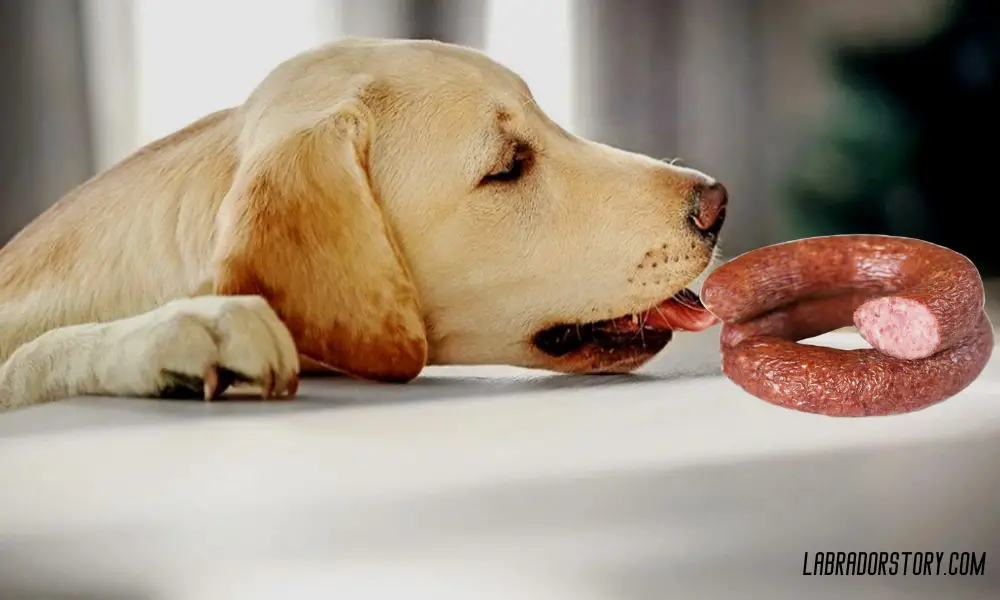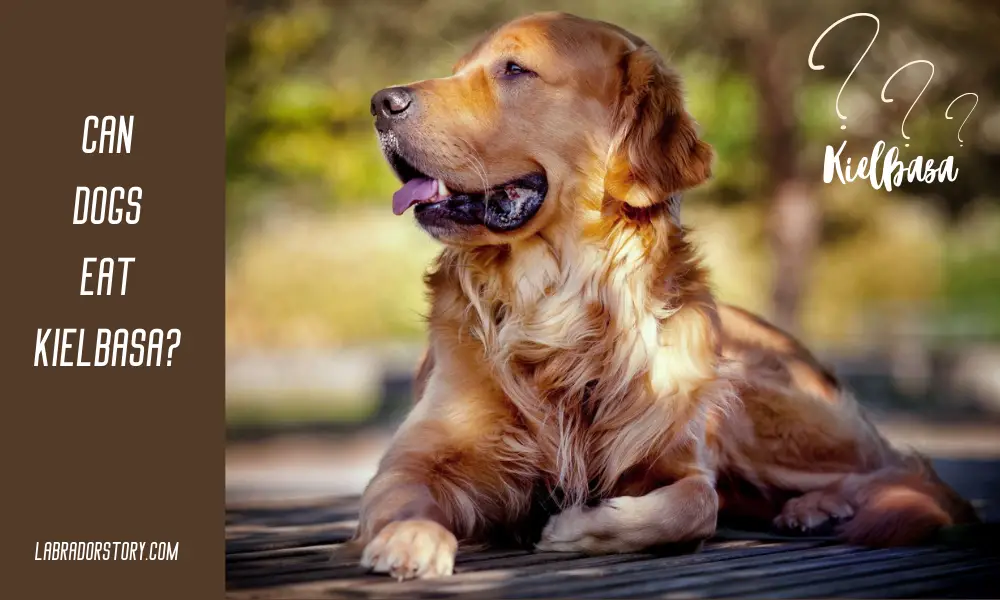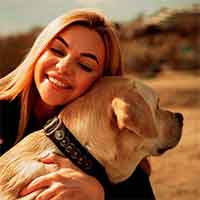Last Updated on January 7, 2024 by Linda Richard
As devoted pet owners, we’re always mindful of what goes into our canine companions’ bowls. The question of whether dogs can indulge in Kielbasa, a flavorful Polish sausage, often arises.
While it’s tempting to share our culinary delights with our furry friends, it’s crucial to understand the potential risks and benefits. In this article, we’ll explore the world of Kielbasa and its compatibility with your dog’s diet, shedding light on the dos and don’ts to ensure your pet’s well-being.
Let’s navigate through the sausage spectrum and make informed choices for your four-legged family member.
Table of Contents
What is Kielbasa and Why Do Dogs Love It?
Kielbasa is one of the most traditional Polish sausages that is made following an age-old method of sausage making. This variety of sausage consists of lean pork, semi-fat pork, sugar, garlic, and spices such as pepper, marjoram, ground mustard seeds, and thyme, which are combined and then chilled before they are stuffed into pork casings. Kielbasa is then smoked and cooked, giving it a distinctive flavor and aroma.
Dogs love Kielbasa because it appeals to their natural instincts and preferences. Dogs are carnivores, and they have a strong sense of smell and taste. They are attracted to meaty and fatty foods, especially those that have been cooked or smoked.
Kielbasa also contains garlic, which is a natural flavor enhancer for dogs. Garlic stimulates the production of saliva and gastric juices, which makes the food more palatable and digestible for dogs.

The Dangers of Feeding Kielbasa to Your Dog
While Kielbasa may seem like a tasty treat for your dog, it is not a suitable food for them according to experts from CanDogsEatAI. There are several reasons why feeding Kielbasa to your dog can be harmful and even dangerous. Here are some of the main risks:
- Kielbasa is high in sodium, fat, and calories. A 2-ounce (56-gram) serving of Polska Kielbasa contains 180 calories, 15 grams of fat, and 490 milligrams of sodium. This is too much for a dog, especially if they eat it regularly or in large amounts. Excess sodium can cause excessive thirst, dehydration, and salt poisoning, which can lead to vomiting, diarrhea, seizures, and even death. Excess fat can cause pancreatitis, which is a painful and potentially fatal inflammation of the pancreas5. Excess calories can cause obesity, which can increase the risk of diabetes, arthritis, heart disease, and other health problems.
- Kielbasa contains garlic, onion, and other seasonings that are toxic to dogs. Garlic, onion, and other members of the allium family (including chives and leeks) contain thiosulfate, which is toxic to dogs but not to humans. Thiosulfate causes oxidative damage to red blood cells, resulting in hemolytic anemia. Symptoms of anemia in dogs include pale mucous membranes, rapid breathing, lethargy, weakness, jaundice, and dark urine. Garlic, onion, and other seasonings can also cause gastrointestinal irritation, nausea, vomiting, and diarrhea in dogs.
- Kielbasa can cause choking, intestinal obstruction, or perforation. Polska Kielbasa is a large and hard sausage that can be difficult for dogs to chew and swallow. If your dog tries to gulp down a whole piece of Kielbasa, they may choke on it or get it stuck in their throat or esophagus. This can cause breathing difficulties, gagging, coughing, and drooling, and may require emergency veterinary attention. If your dog manages to swallow a piece of Kielbasa, it may not be digested properly and may cause an obstruction or a perforation in their stomach or intestines. This can cause severe abdominal pain, vomiting, constipation, bloody stools, and infection, and may require surgery.
How Much Sodium, Fat, and Calories Are in Kielbasa?
As mentioned above, Kielbasa is high in sodium, fat, and calories, which can be harmful to your dog’s health. To give you an idea of how much Kielbasa contains, here are some comparisons with other common foods:
- A 2-ounce (56-gram) serving of Polska Kielbasa contains 180 calories, which is equivalent to 9% of the daily calorie intake for a 50-pound (23-kilogram) dog. This is more than a medium-sized banana (105 calories), a large egg (78 calories), or a slice of whole wheat bread (69 calories).
- A 2-ounce (56-gram) serving of Polska Kielbasa contains 15 grams of fat, which is equivalent to 23% of the daily fat intake for a 50-pound (23-kilogram) dog. This is more than a tablespoon of butter (11 grams of fat), a slice of cheddar cheese (9 grams of fat), or a slice of bacon (3 grams of fat).
- A 2-ounce (56-gram) serving of Polska Kielbasa contains 490 milligrams of sodium, which is equivalent to 20% of the daily sodium intake for a 50-pound (23-kilogram) dog11. This is more than a teaspoon of salt (2300 milligrams of sodium), a cup of chicken broth (860 milligrams of sodium), or a slice of ham (365 milligrams of sodium).

Why Garlic, Onion, and Other Seasonings in Kielbasa Are Toxic for Dogs
Garlic, onion, and other seasonings in Kielbasa are toxic for dogs because they contain thiosulfate and other sulfur-containing oxidants (SCO). These compounds can damage the red blood cells of dogs, causing them to burst and lose their ability to carry oxygen. This leads to hemolytic anemia, which is a condition where the body does not have enough healthy red blood cells to function properly.
The severity of garlic and onion poisoning in dogs depends on several factors, such as the amount and type of allium ingested, the size and breed of the dog, and the duration and frequency of exposure.
Some dogs are more sensitive to garlic and onion poisoning than others, and may show symptoms after eating a small amount. Symptoms can start within 24 hours after eating garlic, onion, or leeks, but more commonly take a few days to appear. Symptoms may include:
- Vomiting
- Diarrhea
- Sore abdomen (belly)
- Reduced appetite
- Dehydration
- Trouble breathing
- Lethargy (low energy)
- Pale gums
- Rapid heart rate
- Jaundice (yellowing of the skin and eyes)
- Dark urine
- Seizures (rarely)
Garlic and onion poisoning can be diagnosed by your vet based on the symptoms, the history of exposure, and blood and urine tests. Treatment may include inducing vomiting, giving activated charcoal, providing intravenous fluids, and administering oxygen and blood transfusions.
With prompt and proper treatment, most dogs recover well from garlic and onion poisoning. However, in some cases, garlic and onion poisoning can cause permanent damage to the kidneys or liver, or even death.

What to Do If Your Dog Accidentally Eats Kielbasa
If your dog accidentally eats Kielbasa, you should contact your vet as soon as possible. Depending on the amount and time of ingestion, your vet may advise you to bring your dog in for examination and treatment, or to monitor your dog at home for any signs of toxicity. Here are some steps you can take if your dog eats Kielbasa:
- Try to estimate how much Kielbasa your dog ate, and when. This will help your vet determine the best course of action.
- If it has been less than four hours since your dog ate Kielbasa, your vet may instruct you to induce vomiting at home, or to bring your dog in for vomiting induction. Do not attempt to induce vomiting without your vet’s guidance, as this may cause more harm than good.
- If your dog has already vomited, or if it has been more than four hours since ingestion, do not induce vomiting. Instead, give your dog plenty of fresh water to drink, and feed them a bland diet of boiled chicken and rice for the next few days. This will help prevent dehydration and soothe their stomach.
- Watch your dog closely for any signs of garlic and onion poisoning, such as vomiting, diarrhea, reduced appetite, pale gums, trouble breathing, lethargy, jaundice, or dark urine. If you notice any of these symptoms, take your dog to the vet immediately, as they may need emergency treatment.
Healthy and Safe Alternatives to Kielbasa for Your Dog
Kielbasa is not a good food for your dog, as it can cause various health problems and complications. However, this does not mean that you cannot treat your dog with some delicious and nutritious snacks. There are many healthy and safe alternatives to Polska Kielbasa that your dog will love, such as:
- Lean meats: Lean meats, such as chicken, turkey, beef, or lamb, are excellent sources of protein, iron, and zinc for your dog. They also contain essential amino acids that your dog needs for muscle growth and repair.You can cook lean meats without any added salt, fat, or seasonings, and cut them into small pieces for your dog to enjoy. You can also use lean meats as ingredients in homemade dog treats, such as meatballs, jerky, or biscuits.
- Fruits and vegetables: Fruits and vegetables are rich in vitamins, minerals, antioxidants, and fiber for your dog. They also provide natural sweetness and moisture that your dog will appreciate. You can feed your dog fresh or frozen fruits and vegetables, such as apples, bananas, blueberries, carrots, cucumbers, green beans, or pumpkin. You can also puree fruits and vegetables and freeze them in ice cube trays for a refreshing treat. However, avoid fruits and vegetables that are toxic to dogs, such as grapes, raisins, onions, garlic, leeks, chives, mushrooms, or avocados.
- Low-fat dairy products: Low-fat dairy products, such as yogurt, cottage cheese, or cheese, are good sources of calcium, phosphorus, and protein for your dog. They also contain probiotics that can help your dog’s digestion and immunity. You can feed your dog low-fat dairy products in moderation, as too much can cause lactose intolerance or obesity. You can also use low-fat dairy products as ingredients in homemade dog treats, such as frozen yogurt, cheese sticks, or muffins.
These are some of the healthy and safe alternatives to Kielbasa that you can feed your dog. Remember to always introduce new foods gradually and in small amounts, and to monitor your dog for any signs of allergies or intolerance.
Also, keep in mind that treats should not make up more than 10% of your dog’s daily calorie intake, and that the main source of nutrition for your dog should be a balanced and complete dog food.
In Conclusion, Can Dogs Eat Kielbasa?
In the quest to determine whether dogs can safely en
joy Polska Kielbasa, it’s evident that moderation and caution are key. While the occasional small bite might not harm your furry friend, the high fat and sodium content pose potential risks.
As responsible pet owners, it’s crucial to prioritize your dog’s health and well-being by sticking to a balanced and canine-friendly diet. Always consult with your veterinarian to address specific dietary concerns and ensure a long, happy, and healthy life for your beloved companion.
Remember, a little love and attention to their nutritional needs go a long way in keeping those tails wagging!
Read also: Can Dogs Eat Graham Crackers?
Read also: Can Dogs Eat Broccoli Stems Or Is This A Bad Idea?

